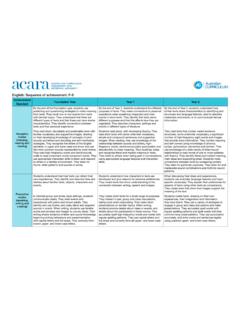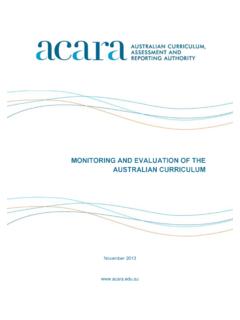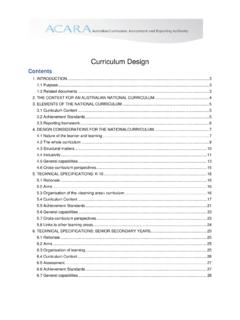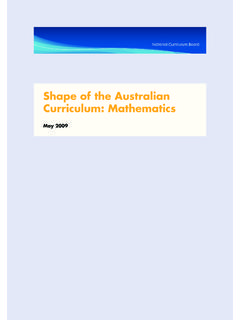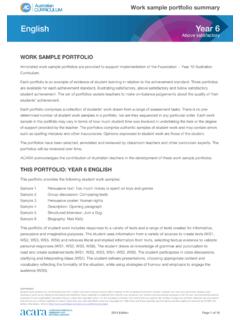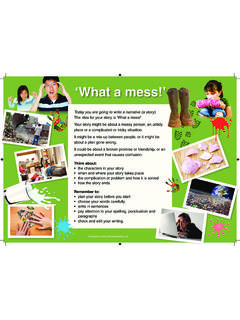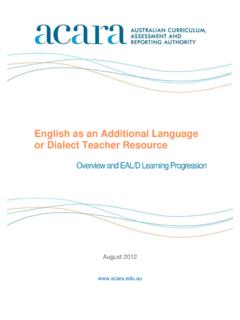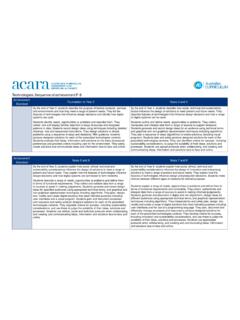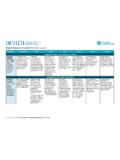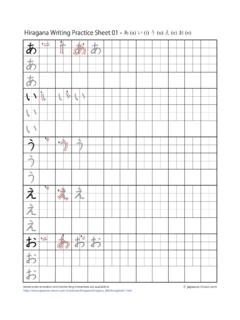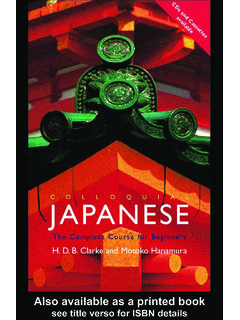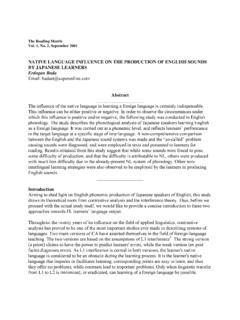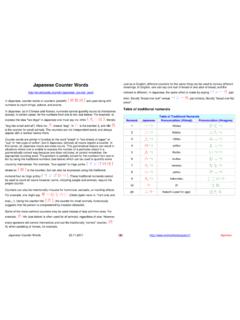Transcription of Australian Curriculum: Languages - ACARA
1 Australian Curriculum: Languages japanese (revised draft) Validation version for public viewing All material in this brochure is subject to copyright under the Copyright Act 1968 (C th) and is owned by the Australian Curriculum, Assessment and Reporting Authority ( ACARA ) 2014. Licence Unless otherwise noted, all material in this brochure except the logo of ACARA , third party icons and any material protected by trademark is licensed under a Creative Commons Attribution-NonCommercial-ShareAlike Australia (CC BY NC SA) licence identified by the following logo: Under a CC BY NC SA Licence, you may download, copy, print and communicate material for personal or non-commercial purposes, including educational or organisational use, provided you attribute ACARA and licence any new work created incorporating material from this website under the same CC BY NC SA Licence. Attribution (Credit ACARA ) All ACARA material licensed under the CC BY NC SA licence must be attributed in the following manner: Unmodified ACARA material: You must credit ACARA in the following manner: Source: Australian Curriculum, Assessment and Reporting Authority ( ACARA ).
2 Modified ACARA material: You must credit ACARA in the following manner: Based on Australian Curriculum, Assessment and Reporting Authority ( ACARA ) materials. Copyright inquiries For all copyright inquiries, please email: or phone: 1300 895 563 (if within Australia) or 61 2 8098 3100 (if outside Australia) Draft Australian Curriculum: Languages japanese 3 DRAFT Australian CURRICULUM: Languages japanese japanese context statement The place of japanese culture and language in Australia and in the world japanese is the official language of Japan, Australia s northern neighbour in the Asian region. It is also widely used by communities of speakers in Hawaii, Peru and Brazil, and learnt as an additional language by large numbers of students in the Republic of Korea, China, Indonesia and Australia. Australia has a significant number of japanese national residents, particularly in the major cities on the eastern seaboard.
3 japanese culture influences many areas of contemporary Australian society, including the arts, design, technology, fashion, popular culture and cuisine. Japan has been a close strategic and economic partner of Australia s for over 50 years, and there is ongoing exchange between the two countries in the areas of education, trade, diplomacy and tourism. Japan is an important nation in the Asian region and a significant contributor to economic, political, and diplomatic relations in the region. The place of the japanese language in Australian education japanese has been taught in Australia for over 100 years and is widely taught as a second language in Australian schools. The 1960s saw significant growth in the learning of japanese , with the establishment of many university programs which produced graduate language teachers who worked alongside native-speaking teachers to establish school-based programs. Increased trade and tourism activity between Japan and Australia in the following decades strengthened interest in japanese language learning, and government funding such as the National Asian Languages and Studies in Australian Schools (NALSAS) Strategy in the 1990s and the National Asian Languages and Studies in Schools Program (NALSSP) in 2008 -2012 contributed to growth and further development in both the primary and secondary sectors.
4 The strong relationship between Australia and Japan has led to many collaborative projects in education and intercultural exchange. The japanese government and private foundations support the teaching and learning of japanese in Australia through funding professional learning and resource development centres and through involvement in educational exchanges. The near-parallel time zones and the geographical proximity of Japan to Australia facilitate easy access, interaction and communication between the two countries. Student exchanges, community engagement such as sister school and city relationships and connections developed through other curriculum areas such as art, design and literature provide opportunities for Australian learners of japanese to interact with japanese people and to engage in cultural experience. Increasing numbers of students benefit from exchanges and in-country experience. Technology provides many additional opportunities for interaction and exchange with japanese -speaking people and cultures.
5 The nature of japanese language learning japanese is the language used by the japanese for education, business and media communication. There are regional dialect variations that are used in spoken interactions. japanese is a phonetic language. Pronunciation is predictable, and new words can be pronounced easily upon mastery of hiragana characters. japanese uses three scripts for writing: hiragana, the basic phonetic script representing the sounds of japanese ; katakana, the companion phonetic script representing the sounds of japanese that is largely used for loanwords; and kanji, Chinese characters which represent meaning rather than sound (ideographs).The three scripts are used interdependently. Hiragana is the first script typically learned, with katakana and kanji first introduced in context then taught systematically, contributing to script knowledge and competence. The many loanwords from other Languages expressed through katakana reflect the impact of globalisation, technology and popular culture on japanese language and culture.
6 japanese grammar is relatively uniform, with few irregularities, no grammatical gender and predictable and systematic conjugation of adjectives and verb tenses. There are some differences between japanese and English elements and patterns, such as the japanese word order of subject object verb. This order forms the basis of sentences that can then be enhanced by the addition of details usually placed before the main items. Pronouns can be omitted and it is not always necessary to articulate the subject of a sentence. Counting and numbering in japanese involve using classifiers which reflect the nature of the item. Particles are used to mark sentence elements and to indicate the nature of verbs. Draft Australian Curriculum: Languages japanese 4 An element of the language that may be unfamiliar to some Australian learners is the system of plain and polite forms, which reflect hierarchical relations, social and business-related positioning and issues of respect and status.
7 These are differently shaped in spoken and written language. Conversational japanese can be less formal than written japanese , using shortened sentences, abbreviated plain forms and some omitted particles. Another feature of japanese culture reflected in language use is the importance accorded to expressing humility and to maintaining harmony. Refusing or deflecting praise of self or family, self-deference and avoidance of direct disagreement or refusal are common characteristics of communicative interactions. A key dimension of the curriculum involves understanding the cultural dimension that shapes and is shaped by japanese language. The curriculum is designed with an intercultural language learning orientation to enable students to participate meaningfully in intercultural experiences, to develop new ways of seeing and being in the world, and to understand more about themselves in the process. The diversity of learners of japanese While learners of japanese in Australian schools vary in terms of language backgrounds, cultural experience and prior learning experience, they are predominantly second language learners.
8 Classes may include students with a background in japanese or in a script-based Asian language. Some students will have had exposure to japanese language and culture through social interactions, travel or exchange experiences. The Australian Curriculum: Languages for japanese is pitched for the majority of the cohort of learners of japanese for whom japanese is an additional language (referred to in the Australian Curriculum as second language learners). The curriculum has been developed according to two main learning sequences for these learners, Foundation to Year 10 Sequence and Years 7 to 10 (Year 7 Entry) Sequence. Teachers will use the curriculum to cater for the range of different learner backgrounds described above by making appropriate adjustments to differentiate learning experiences for these students. Draft Australian Curriculum: Languages japanese 5 DRAFT Australian CURRICULUM: Languages japanese FOUNDATION TO YEAR 10 SEQUENCE japanese (F 10 Sequence) curriculum Foundation to Year 2 Band description The nature of the learners Children enter the early years of schooling with established communication skills in one or more Languages and varying degrees of early literacy capability.
9 For young students learning typically focuses on their immediate world of family, home, school, friends and neighbourhood. They are learning how to socialise with new people, share with others and participate in structured routines and activities at school. Typically they have little to no experience of japanese language and culture. japanese language learning and use The initial focus is on listening to the sounds and patterns of japanese through language-rich activities such as rhymes, songs, clapping and action games. Repetition and recycling help children to identify frequently used words, simple phrases and non-verbal communication strategies employed in greetings and other social interactions. They experiment with simple responses to prompts and cues. They are introduced to the scripts through a first focus on high-frequency kanji, focusing on their ideographic nature before learning the associated japanese sounds. They learn hiragana using a play-based approach that incorporates chanting, the use of mnemonics and a focus on the creative and crafted process of writing japanese kana.
10 As they learn to read hiragana they draw on first language literacy skills such as predicting or linking unfamiliar elements with familiar ones. Reading skills begin with recognition of single kanji or hiragana and progress to reading whole words and familiar phrases. Writing skills progress from labelling pictures with single kanji and tracing and copying words in hiragana to scaffolded writing of words and short phrases. As they progress to using japanese for functions such as asking and answering questions, responding to classroom instructions, singing songs, and taking turns in games and simple shared tasks, children begin to notice that language behaves differently in different situations and that japanese speakers communicate in some ways that are different to their own. They practise and repeat formulaic expressions and gestures such as bowing that differ in japanese from ways of communicating in English. Creative play provides opportunities for exploring these differences and for using japanese for purposeful interaction.
